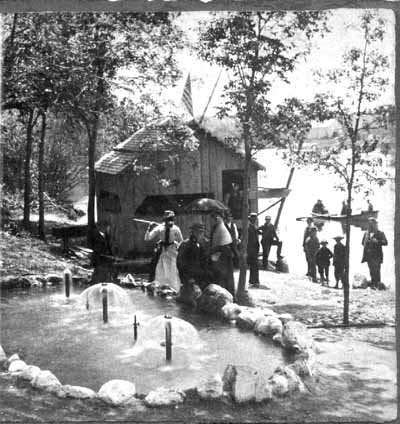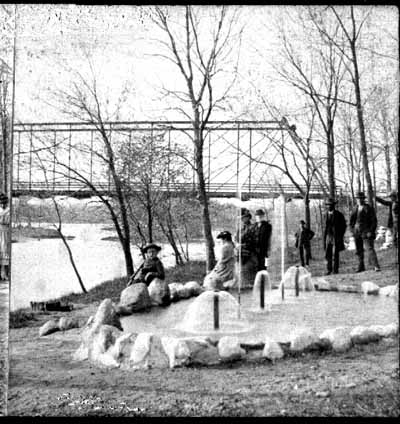Rosenkrans, the Man and His Park
By Martin E. Nass
Transcribed for the IAGenWeb Project by Janelle Martin, with permission of Martin "Ed" Nass.
Selim B. Rosenkrans was born in New York in 1824, in a log house with an
attached "linter," where his father plied his trade as a wagon maker. His
father moved the family to Hammondsport, a town at the head of Lake Keuka,
which connected with the Erie Canal. By this time his father operated a saw
mill, wagon works, and operated a canal boat. Selim began operating the boat
when he was 16 years of age.
In early 1856, he married Charlotte Larrowe and moved with his wife to Webster
City. He went into partnership with C. T. Fenton and operated a steam sawmill.
He purchased extensive lumber land, some town lots, and dealt in real estate.
In June, 1856, he served as a delegate to the first Republican convention
ever held in Iowa, where the party was organized into a congressional district
that encompassed the whole northern part of Iowa.
Rosenkrans read the Episcopal burial service for the first funeral held in
Webster City, because there was no clergy here then. He delivered the first
Fourth of July celebration address on July 4, 1857. He was elected clerk
of the first Agricultural Society of Hamilton County. He was also elected
president of the first building association. He built the first brick commercial
structure in Webster City that housed three businesses operated by L. L.
Estes, L. L. Treat, and Kendall Young. That location today is occupied by
the Seneca Street Saloon. The upper floor of the building served as the first
town hall and courtroom. For a time high school classes were held here also.
Examples of his public service included the following: Representative for
Hamilton and Story County in 1859 and 1861, appointed drafting commissioner
by Governor Kirkwood for Hamilton and Wright Counties during the Civil War,
and was elected Mayor of Webster City. Afterwards, he served several terms
on the City Council.
Rosenkrans was one of seven members who re-organized the Congregational Church,
and he became associated in business with Walter C. Willson and Jacob M.
Funk in the building of the Crooked Creek Railroad. He continued his business
interests by building the second post office, by constructing the Grand Central
Hotel, and by building a number of other business houses and many private
homes.

His major contribution to Webster City, according to some, was
the building of Rosenkrans Park. It was located at the east end of the Bank
Street Bridge on property today owned by Roger and Berneta Balsley. Selim
personally developed the property into a fine park, creating paths, planting
flowers, trees and shrubs, and utilizing four mineral springs that flowed
at the base of the park. The main entrance to the park was at the intersection
of Park Street and Dubuque Street. Rosenkrans operated a boating house in
the park that rented canoes and rowboats. The body of water on the Boone
was considerably wider then, due to the Chase Mill dam, which backed up water
to the Illinois Central Railroad bridge. A small steamboat, the "Daniel Boone,"
was built and operated by Capt. Ed Mabbott.
Rosenkrans Park had its grand opening on June 4, 1885, with a crowd of 2,500
people in attendance, according to the account in the Hamilton Freeman. It reported that
Samuel Baxter stood by the flowing wells which he said have helped various
ones to over 1,000 glasses of mineral water. About 40 people came on a special
train belonging to the Crooked Creek Railroad from Lehigh. The Lehigh nine
played the local team in a game of baseball and succeeded in "walking away
with them." The Webster City cornet band met every train and later provided
excellent music on the grounds. At about 7:30 p.m., the band serenaded S.
B. Rosenkrans at his residence at the corner of Seneca and First Street.

The June 9, 1886, edition of the Hamilton Freeman announced the Second
Annual Opening of Rosenkrans Park on June 4th. The article continued,
"At about 10 a.m. two brass bands met excursion trains on both the Illinois
Central and the Northwestern depots. It is estimated that there were over
3,000 people enjoying the park, enjoying the shade, drinking the water, and
having a good time at the popular resort. Capt. Lewis Crary and Col. George
W. Crosley were chairmen of the program which took place at 11 o'clock. Rev.
L. N. Call gave the prayer, Wesley Martin responded to a toast, and an account
of his first arrival in this city. He continued with his view of Webster
City in one hundred years. He predicted that the President of the United
States would be in attendance at the centennial opening of Rosenkrans Park."
The program concluded with a fireman's dance in the evening.
The June 8th, 1887, edition of the Hamilton Freeman announced
the Third Annual Opening of the Park with the arrival of special trains from
Lehigh. The brass band escorted the 125 excursionists from the depot to the
park under the direction of Marshall A. P. Fleming. Rev. L. N. Call again
gave the invocation; Hon. Walter C. Willson, as President of the Day, presided
over the activities. Little girls also took part in the program with their
singing and drilling. After the benediction by Rev. W. W. Nutting came the
basket dinner. At 2:30 p.m. members of the Duprez and Benedict Brass Band,
with red coats and brass helmets, were followed by the Tama City and Webster
City baseball teams to the courthouse, then north to Second Street, and then
west on Second Street to the Driving Park (where the Webster City High School
now stands). Webster City won the game 11 to 2.
For the Fourth Annual Opening, the Hon. Walter C. Willson was again the President
of the Day. This year the Riverside Band of Randall led the parade to the
park. For the first time a queen was selected; she was Miss Nellie Evans.
Hon. John Dolliver gave an address which was a tribute to the pioneer men
and women of Hamilton County. Little Ivy Layne, the wonderful child singer,
rendered the familiar war song, "Marching Through Georgia." The Williams
band performed at the park. There was a crowd of about 3,000 people from
Fort Dodge, Lehigh, Williams, Jewell, and Eagle Grove in addition to the
home crowd. Again, an afternoon ballgame at the Driving Park pitted Lehigh
against Fort Dodge.
The programs in ensuing years followed the same format. Each year all businesses
in the community closed on June 4th , so the employees could attend
the festivities. In 1890 Frank Clothing offered a Grand Park Opening offer
of a free bat and ball for every child whose parents purchased a new child's
suit.
Rosenkrans' first wife, Charlotte, died in 1888. He married Mary S. Steadman
in 1891.
Eventually the enthusiasm for the park faded. Rosenkrans was called "Old
Rosey" by some individuals as they made fun of him and his park. The local
business men began to grumble that they were losing business by closing,
so they decided on business as usual. The grumbling caught the attention
of the young people in our community, who decided to vandalize the park.
They tore out the flower beds, cut down the trees and shrubs, plugged up
the flowing wells, and generally destroyed the park. Mr. Rosenkrans was
distraught. He sold the property to E. A. Stare, who planned to convert it
to private property. A farewell picnic was held on June 4, 1894, after which
Rosenkrans moved to Perry, Iowa.
Rosenkrans died on July 7, 1902. His body was brought home once again, and
he was buried in Graceland Cemetery of the city he worked so hard to build.
|